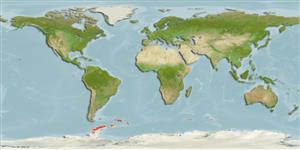Teleostei (teleosts) >
Perciformes/Notothenioidei (Icefishes) >
Nototheniidae (Cod icefishes) > Nototheniinae
Etymology: Gobionotothen: Latin, gobius = gudgeon + see under Notothenia; gibberifrons: gibberifrons from Latin giber a hump, frons forehead, humped forehead (Ref. 11892).
More on author: Lönnberg.
Environment: milieu / climate zone / depth range / distribution range
Ecology
Marine; demersal; depth range 6 - 429 m (Ref. 11892). Polar; 53°S - 67°S, 75°W - 75°E
Southern Ocean: Scotia Arc and Heard Island. Also distributed in the South Atlantic, near the southern Shetland, southern Sandwich, southern Orkney Islands, and near South Georgia Island (Ref. 4883).
Length at first maturity / Size / Weight / Age
Maturity: Lm 37.7 range ? - ? cm
Max length : 55.0 cm TL male/unsexed; (Ref. 5179); common length : 40.0 cm TL male/unsexed; (Ref. 2121)
Dorsal
spines
(total): 6 - 8;
Dorsal
soft rays
(total): 31-34;
Anal
soft rays: 31 - 34. Upper part of head and body irregularly spotted and blotched. Rarely with traces of darker cross-bars, young with irregular cross-bars, broken up into three or four series of alternating spots (Ref. 11892).
Mature females may spawn for the first time from around 6-8 years of age (Ref. 71843).
Dewitt, H.H., P.C. Heemstra and O. Gon, 1990. Nototheniidae. p. 279-331. In O. Gon and P.C. Heemstra (eds.) Fishes of the Southern Ocean. J.L.B. Smith Institute of Ichthyology, Grahamstown, South Africa. (Ref. 5179)
IUCN Red List Status (Ref. 130435)
Threat to humans
Harmless
Human uses
Fisheries: minor commercial
Tools
Warning: mysqli::__construct(): (HY000/1040): Too many connections in /var/www/html/includes/speciessummary.lib.php on line 2414
Can't connect to MySQL database fbquizv2. Errorcode: Too many connections
